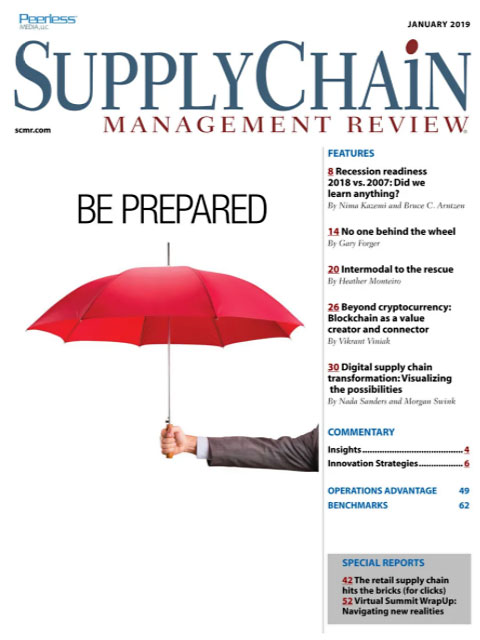Sorry, but your login has failed. Please recheck your login information and resubmit. If your subscription has expired, renew here.
January-February 2019
Truth be told, I was not a Boy Scout, or at least not a very good scout and not for very long. But I think there are some lessons for supply chain managers in the Scout motto: Be prepared. When I Wiki’d it this morning, I found the following: Be prepared, which means you are always in a state of readiness in mind and body to do your duty. Browse this issue archive.Need Help? Contact customer service 847-559-7581 More options
Most, if not all, supply chain managers recognize that a digital revolution is overtaking supply chain management. It is fueled by three major trends.
Big Data. Data is being generated up and down the supply chain by transaction-based monitoring and enterprise systems, such as point of sale, RFID and ERP systems, as well as by unstructured data sources, including clickstreams, camera and surveillance footage, imagery, social media postings, blog/wiki entries and forum discussions.
Advances in computing. Enormous advances in computing power and intelligence are automating Big Data processing and analysis. Computing architectures such as cluster computing, Cloud computing and mobile computing have made storage, retrieval, analysis, sharing and distribution of data faster and cheaper.
Advances in robotics. In combination with advances in hardware and software, robotics and robotic process automation are quickly making the automation of manual and transactional processes cheaper and more reliable.
Because of these advances and the hype surrounding them, many supply chain leaders view digitization as a mandate for competition, yet first steps and an overall strategy are unclear. Important questions include:
- What is the “digital supply chain” in terms of its definition and core elements?
- What are the main opportunities and challenges?
- What are the key enabling technologies?
- Are we already behind? Where do companies really stand compared to the hype?
- How do we move forward?

This complete article is available to subscribers only.
Log in now for full access or start your PLUS+ subscription for instant access.
SC
MR
Sorry, but your login has failed. Please recheck your login information and resubmit. If your subscription has expired, renew here.
January-February 2019
Truth be told, I was not a Boy Scout, or at least not a very good scout and not for very long. But I think there are some lessons for supply chain managers in the Scout motto: Be prepared. When I Wiki’d it this… Browse this issue archive. Access your online digital edition. Download a PDF file of the January-February 2019 issue.Most, if not all, supply chain managers recognize that a digital revolution is overtaking supply chain management. It is fueled by three major trends.
Big Data. Data is being generated up and down the supply chain by transaction-based monitoring and enterprise systems, such as point of sale, RFID and ERP systems, as well as by unstructured data sources, including clickstreams, camera and surveillance footage, imagery, social media postings, blog/wiki entries and forum discussions.
Advances in computing. Enormous advances in computing power and intelligence are automating Big Data processing and analysis. Computing architectures such as cluster computing, Cloud computing and mobile computing have made storage, retrieval, analysis, sharing and distribution of data faster and cheaper.
Advances in robotics. In combination with advances in hardware and software, robotics and robotic process automation are quickly making the automation of manual and transactional processes cheaper and more reliable.
Because of these advances and the hype surrounding them, many supply chain leaders view digitization as a mandate for competition, yet first steps and an overall strategy are unclear. Important questions include:
- What is the “digital supply chain” in terms of its definition and core elements?
- What are the main opportunities and challenges?
- What are the key enabling technologies?
- Are we already behind? Where do companies really stand compared to the hype?
- How do we move forward?
SC
MR


Latest Supply Chain News
- How S&OP provides the answer to in-demand products
- AI, virtual reality is bringing experiential learning into the modern age
- Humanoid robots’ place in an intralogistics smart robot strategy
- Tips for CIOs to overcome technology talent acquisition troubles
- There is still work to do to achieve supply chain stability
- More News
Latest Podcast

 Explore
Explore
Software & Technology News
- AI, virtual reality is bringing experiential learning into the modern age
- Humanoid robots’ place in an intralogistics smart robot strategy
- Tips for CIOs to overcome technology talent acquisition troubles
- Game on: Rethinking change management for the digital era
- Predicting stockouts: Enhancing FMCG resilience through data-driven insights
- Top Performers Investing in, Benefitting from AI
- More Software & Technology
Latest Software & Technology Resources

Subscribe

Supply Chain Management Review delivers the best industry content.

Editors’ Picks






